Garden Spiders: Black and Yellow Garden Spider, Brown Spiders and More – Identification Guide (Pictures)
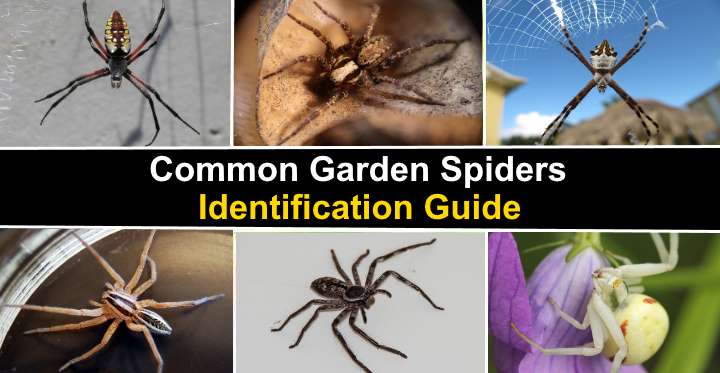
The garden spider (Argiope aurantia) is a black and yellow spider that is a common sight in late summer. Also named, yellow garden spider, you can identify the garden spider by its yellow and black markings and eight long spindly legs. Garden spider (Argiope aurantia) also has the names zigzag spider, corn spider, zipper spider, Steeler spider, golden garden spider, writing spider, golden orb-weaver, and McKinley spider.
The black and yellow spider (Argiope aurantia) is venomous and can give a nasty bite, but it is not a deadly spider. However, you should still handle this spider with care to avoid getting bitten.
This article is a guide to identifying the black and yellow garden spider. Later on you’ll find information on identifying other types of common garden spiders.
Black and Yellow Spider Facts

The yellow garden spider (Argiope aurantia) is a large spider with long legs that can bite when threatened
Black and yellow garden spider (Argiope aurantia) is a large spider species in the genus Argiope and class Arachnida. The Argiope aurantia species is part of the orb-weaving group of spiders. The name ‘orb-weaving’ refers to the circular-like patterns these spiders spin on their sticky spiral webs.
The yellow garden spider (Argiope aurantia) is generally harmless even though it can inflict a painful bite. The garden spiders tend to scurry away quickly if you disturb their habitat. However, they will bite if they feel under threat.
Black and yellow spiders are found in a wide range of habitats. Usually, you’ll find these big spiders in gardens in late summer. Unlike some spider species, the garden spider (Argiope aurantia) spins its webs in the open where it catches insects. You’ll usually find these large spiders hanging upside-down in the center of their webs, waiting for their prey.
Female yellow garden spiders lay their eggs in a brown sac that measures up to 1” (2.5 cm) in diameter. There can be up to 1,000 eggs in each sac. The adult spiders die off during the first frost. Young spiders hatch from the sac in spring.
In summer gardens, it’s usually the female spiders that you notice waiting in large circular webs.
What Does A Garden Spider Look Like?

You can identify Argiope aurantia garden spider by its attractive black and yellow stripes and spots on the abdomen
Garden orb weaver spiders have identifying striking yellow and black zigzag patterns on their abdomens. You will also notice a white head at the top end of their elongated oval body. These eight-legged arthropods have orange/yellow and black banded legs. Female black and yellow spiders have a leg span of about 3” (7.5 cm).
Black and yellow spiders have a distinctive appearance on their webs. Their long thin legs create the silhouette of the St. Andrew’s cross in a sort of X-shape. Usually, on the webs, the male and female spiders keep their pairs of legs together. From a distance, the black and yellow garden spiders look like they have only four legs.
The black and yellow stripes and markings of Argiope aurantia give them a menacing look. But there’s nothing usually to worry about as their striking appearance is camouflage or deterrent against larger prey.
Black and Yellow Spider Identification
The black and yellow spider (Argiope aurantia) can be identified by its black body with vivid yellow markings. The golden-yellow markings are mostly on the side of their abdomens. Sometimes, the female abdomens look like they have a black and white zigzag pattern. Their long legs are mostly black with light tan bands.
Male Garden Spider Vs. Female Garden Spider
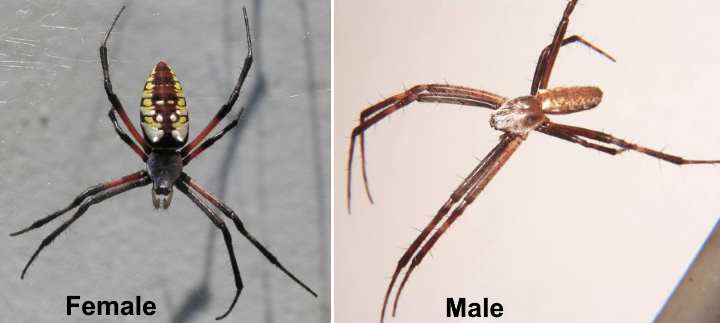
Argiope aurantia female spider (left) and male (right)
It’s easy to tell male garden spiders apart from the female species. The female garden spider is a distinctive black spider with yellow stripes. The male spiders in the Argiope aurantia species are brown spiders without the black and gold markings. The male spiders are not as large as the female ones—a common trait among most spider species.
The male brown garden spiders are generally more reclusive than the females. If you see species of these spiders in your garden, it’s generally the black and yellow female spiders, not the brown male spiders on the circular webs.
What Does the Black and Yellow Spider Eat?
Common garden black and yellow spiders feast on a diet of aphids, wasps, bees, and other flies and insects. The black and yellow female or brown male spiders wait on webs for insects to get caught. Once the insect stops moving, the spider wraps its meal in a silky web. The spider then moves in for the kill and injects venom into the fly or insect.
Female spiders also have interesting eating habits. At night, female black and yellow garden spiders eat their own webs. They then spin new ones, ready for catching more prey to consume the next day.
Garden Spider Life Cycle
The common garden spider lives for just over one year. After laying hundreds of eggs in one or more sacs, the female will live until the first frost after mating. The brown male garden spider usually dies after mating. The minuscule baby spiders hatch in spring or late summer, depending on the climate.
In warm climates, female black and yellow spiders can live for many years.
Is the Black and Yellow Garden Spider Native to North America?
Black and yellow garden spiders are native to North America. You can find these common black and yellow striped spiders in gardens in nearly all states in the US and some parts of southern Canada.
Is the Black and Yellow Spider Good for Gardens?
Black and yellow striped spiders are beneficial for your garden’s biodiversity. Common garden spiders catch and feed on destructive flying insects such as aphids. Just like many beneficial insects, black and yellow garden spiders help ensure your garden’s ecosystem thrives. Most flying insects get trapped in their orb webs if they fly into them and that helps
Does the Garden Spider Bite?
Garden spiders can bite, but it’s rare. Although the common garden spiders look aggressive with their black and gold or black and white stripes, they are relatively timid. They are more likely to scamper away if you disturb one. However, if you happen to grab one, garden spiders may bite you.
Is the Black and Yellow Spider Poisonous?
Black and yellow garden spiders contain venom that can cause redness and swelling if they bite you. However, there are usually no complications from their bite, and the pain and swelling are comparable to a bee’s sting.
It’s good to remember that only a few spiders have harmful bites. The toxins from garden spiders are not life-threatening. There are only four species of dangerous spiders native to North America. These dangerous spiders are the black widow, hobo spider, yellow sac, and the brown recluse.
Other Types of Spiders Found in the Garden (With Pictures and Identification Guide)
Black spiders with yellow stripes are common in many North American gardens. But with over 3,000 species of spiders found in US gardens, the chances are that you’ll have more than common yellow orb spiders.
Here are more spider species that you might find in your front or backyard.
Orb Weaver Spiders

Arrowhead orb weaver spider (Verrucosa arenata) is common in North America in forests, gardens or hiding in dark areas
Black and yellow garden spiders are a type of orb-weaving spider in the family Araneidae. However, there are hundreds of orb spider species in the US. You can identify orb weavers by their circular-shaped webs. However, there are many variations between orb-weaver species.
Orb-weaver spider identification: Orb weavers are generally identified by their bulbous, oval abdomen, and colorful markings. Apart from being black and yellow, species of orb spiders can be brown, orange, tan, and white. Generally, orb spiders have zigzag or striped abdominal patterns. Another identifying feature of orb weaver is their long, spindly legs.
Banana spiders (Nephila)
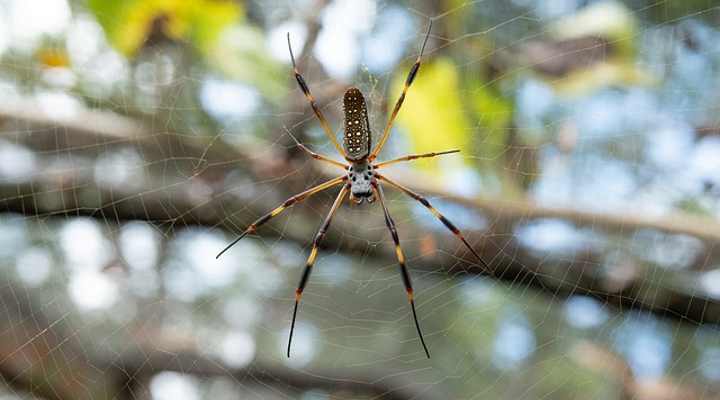
Banana spiders have oblong brown body with striped legs
Also called giant wood spiders or golden orb-weavers, these large black spiders also have yellow stripes. This makes it difficult to distinguish between banana spiders and common garden spiders. However, there are a few ways to tell the difference between these similar orb spiders.
Banana spider identification: Banana spiders have an oblong, square body rather than a rounded one. Banana spider’s legs are not grouped in pairs like garden spiders but are evenly distributed around the body. These large spiders spin giant webs up to 3 ft. (1 m) long.
Banded Garden Spider (Argiope trifasciata)

The banded garden spider has yellow, white and brown-black bands on its legs and body
Banded garden spiders are native to North America. This spider gets its name from the dark brown or black bands on its tan-colored abdomen and legs. These brown garden spiders are also called the banded orb-weaving spider.
Banded garden spider identification: Banded garden spiders have yellow, white, and black bands on their abdomen. The spider’s body shape looks like a rounded triangle up to 1” (2.5 cm) in length. These brown garden spiders have long banded legs, grouped in pairs, similar to how common garden spiders look.
Sac Spiders (Spider Family Clubionidae)
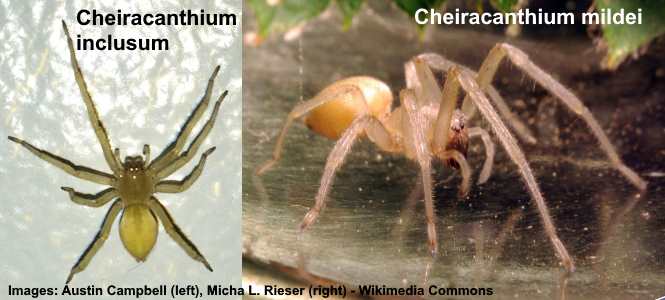
Yellow small sac spiders are commonly found in gardens, but come inside homes in cold weather
The most common sac spiders native to North America are the northern yellow sac spider (Cheiracanthium mildei) and the American yellow sac spider (Cheiracanthium inclusum). Yellow sac spiders are known for their venomous painful bite and fast running ability. These light-tan or yellow-colored spiders invade homes in the fall when the weather cools. According to researchers, yellow sac spiders account for most spider bites in the US.
Yellow sac spider identification: Yellow sac spiders are small light tan spiders growing up to 0.4” (1 cm) long. The sac spiders have slightly furry bodies and tan legs with darker claws at the end. Yellow sac spiders live under bark, between leaves, or on plants.
Grass Spider (Spider Family Agelenidae)

Grass spider Agelenopsis pennsylvanica (left) and hobo spider Eratigena agrestis (right)
Grass spiders are medium-sized garden spiders with fuzzy brown bodies and dark stripes. You’ll also notice the spider species has long, thin banded legs. Most species of grass spiders have harmless bites. However, the hobo spider (Eratigena agrestis) can inflict a painful bite. They also have the collective name funnel-web spiders.
Grass spider identification: Grass spiders are generally small spiders measuring up to between 0.6” and 0.8” (1.5 – 2 cm) long. These fast-moving brown spiders have two dark brown lines running the length of their head and body. Grass spiders spend most of their time in gardens and rarely venture indoors.
Wolf Spiders (Lycosidae)

Wolf spiders have furry striped body and painful bite
Wolf spiders look like grass spiders, but they have a hairier body and can inflict a painful bite. Wolf spiders are unique in the class of Arachnida as they have excellent vision. Looking at pictures of these furry brown spiders, you’ll see their eight eyes arranged in three rows.
Because of their behavior and color, these spiders are also called brown hunting spiders.
Wolf spider identification: Wolf spiders are identified by their furry brown bodies and darker striped markings. Wolf spiders usually have legs the same color as their bodies. Depending on the species, wolf spiders can have brown and orange or brown and black markings. Wolf spiders grow up to 1.3” (3.5 cm) long.
Filmy Dome Spider (Neriene radiata)

Filmy dome spiders have dark brown and yellow or white body with thin long legs
Filmy dome spiders are brown spiders with smooth bodies that belong to the genus Neriene. As a type of sheet weaver spider, filmy dome spiders spin horizontal webs. You will often see these slender spiders hanging upside down from their webs as they wait for their prey.
Filmy dome spider identification: Filmy dome spiders are recognized by their slender dark brown bodies with yellow or white markings and enlarged palps (antenna-like appendages on their heads). Filmy dome spiders have long, thin legs that are light brown to tan in color. You commonly find these spiders in gardens under fallen logs.
Western Lynx Spiders (Oxyopes scalaris)

The small western lynx spider has brown body with spiny striped legs
Native to North America, western lynx spiders are small brownish spiders with spiny legs. Western lynx spiders are generally found in gardens among tall grass and other vegetation. They get their name from how they stalk their prey—similar to how a wild cat would behave.
Wester lynx spider identification: Western lynx spiders have bronze-colored compact bodies and striped legs. You can quickly identify lynx spiders by the spines on their legs, giving the long legs a jagged, spiny look. Western lynx spiders grow to between 0.15” and 0.6” (1.5 cm).
Woodlouse Hunter (Dysdera crocata)

The woodlouse hunter is a reddish brown spider with large mouthparts and smooth body
Woodlouse hunters are a red to orange species of spider with a shiny, smooth body. The spider gets its common name from its prey—woodlice. Other names for this spider species are sowbug spiders, pillbug hunters, and slater spiders. You’ll find woodlouse hunters under logs, rocks, and leaves.
Woodlouse spider identification: Woodlouse spiders are non-spinning spiders with a large dark-red head and slender yellow-brown abdomen. Up close, you’ll see that their chelicerae (mouthparts) are disproportionately large for the size of spider. Woodlouse spiders grow up to 0.6 (1.5 cm) long.
Huntsman spiders (Spider Family Sparassidae)
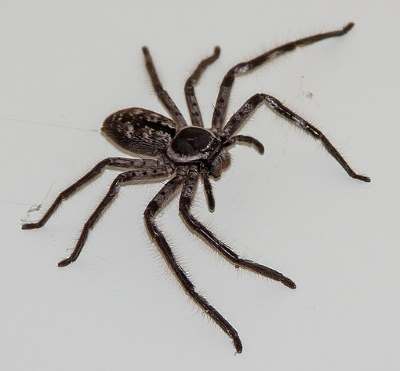
Huntsman spiders have brown or gray hairy body with big leg span
Huntsman spiders are big brown spiders with huge long legs. Because of their scary appearance and long legs, these spiders are also called giant crab spiders and lizard-eating spiders. Huntsman spiders also look like tarantulas and can also give a nasty bite. Huntsman spiders have a leg span of up to 6” (15 cm) with small bodies 0.7” (1.8 cm) long.
Huntsman spider identification: Huntsman spiders’ identifying characteristics are their crab-like legs. Most huntsman spider species are shades of brown or gray with furry bodies. Very few of these spiders have identifiable markings.
Flower Crab Spiders (Misumena vatia)
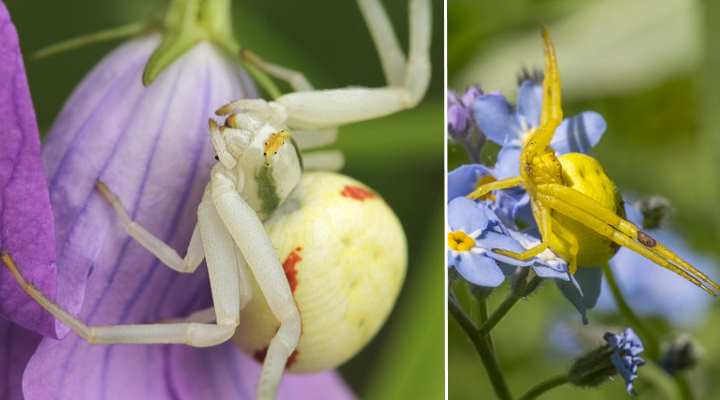
The small flower crab spider (goldenrod crab spider) can be white or yellow with oval short body and crab-like legs
Flower crab spiders (Misumena vatia) can be white or yellow spiders depending on the flowers they hunt from. These unusual spiders have oval short bodies with eight crab-like legs. Because the spiders can sometimes be yellow, they are called banana spiders. Yellow or white crab spiders feed on bumblebees, flies, grasshoppers, and butterflies.
Another name for flower crab spiders is the goldenrod crab spider. Similar to crabs, these spiders can walk sideways.
Flower crab spider identification: Flower crab spiders are small spiders, either a yellow or white color. Their identifying feature is their oval body that looks like a button mushroom with eight, crab-like legs.
Silver Garden Spider (Argiope argentata)
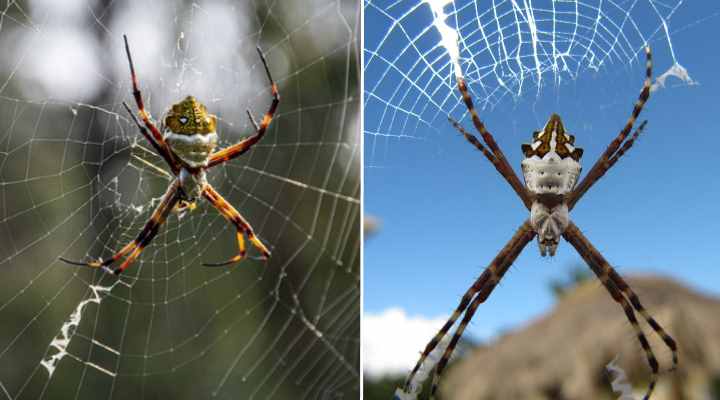
Silver garden spider upper view (left) and underside view (right)
Silver garden spiders are orb-weaving spiders with brown or orange zigzag patterns on their abdomens. In this species, the female spiders are about three times the size of the males. Silver garden spiders are found in the warmer states of the US, such as Florida, Texas, and California.
On the orbital web, silver garden spiders create an X-shape with their bodies and legs. Their large abdomen has a silvery appearance on the underside and horn-like protrusions. Some species of these garden spiders have orange, yellow, or white bands on their bodies.
Silver garden spider identification: Silver garden spiders have a silver-colored body and can have black, orange, yellow, or white markings. Other identifying characteristics of these orb-weaver garden spiders are long black or brown legs that have distinctive banding.
Learn about other common spiders that can be found in your home or garden.
Related articles:
